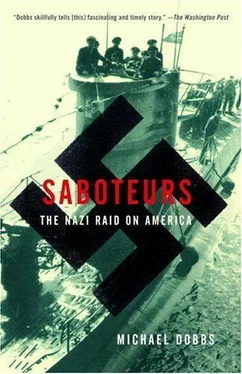Meanwhile, final preparations were under way for the landing of the V-men. Dasch gave each member of his group a money belt and pocket money. Linder ordered the men to go through their belongings and remove potentially incriminating German items such as cigarettes. The saboteurs also tried as best they could to straighten out the civilian clothes they would wear in America: after three weeks in a seabag, they were very wrinkled. 45
As the submarine nosed its way toward the shore, Linder summoned his officers and the saboteurs to decide how to carry out the landing operation. 46He planned to sail toward the coast at very slow speed using just his electric motors, rather than the noisy diesel engines, to avoid alerting the Coast Guard. He would keep the deck a few inches above the surface of the waves until the boat scraped the sandy sea bottom, indicating that it was close to the shore. He would then land Dasch and his men, blow his water tanks to lift the U-boat off the bottom, and make off.
For the landing operation itself, Linder selected two of his strongest sailors to row the saboteurs ashore in a rubber dinghy he had brought along for this purpose. A line would be attached to the dinghy to guide the boat back to the submarine once the V-men were ashore. If the landing party encountered anyone patrolling the beach, Linder ordered, they were to overpower him and send him back to the submarine for interrogation. In addition to removing a potential threat to the mission, the capture of a coastguardsman would provide the German navy with intelligence on American coastal defenses. 47The sailors would also bring back the navy fatigues worn by the saboteurs during the landing operation.
When the U-boat surfaced, it was still extremely foggy. As planned, they had arrived on an almost moonless night, with visibility less than a hundred yards. From his post in the control room, Linder could not make out the shoreline, but he could hear the pounding of the surf against the beach, suggesting they must be very close to land.
The U-boat touched the sea bottom with a shudder and then swung around with the tide so it was parallel to the shore, with the heavier starboard side facing land. 48By now, it was nearly midnight, U.S. Eastern War Time, six o’clock in the morning in Berlin, the time kept by the U-boat fleet. Linder ordered the landing party up on deck, along with their crates of bomb-making equipment and the seabag full of civilian clothes. “Christ, this is perfect,” murmured Dasch, as he emerged onto the fog-shrouded deck. 49
The saboteurs were dressed in the navy clothes they had picked up in Berlin. Quirin and Heinck wore German marine caps with swastika insignias, Dasch a dark brown fedora hat. They scrambled into the dinghy, Dasch squatting in the stern, Burger next to him clutching both the seabag and a briefcase crammed with bundles of fifty-dollar bills.
Linder told the sailors to pull away from the submarine at a ninety-degree angle so they would be heading toward the shore. But after a few minutes’ rowing, they lost their sense of direction. The fog was so thick it was impossible to make out either the shoreline or the submarine. At times the roar of the surf seemed to be coming from the right, at other times from the left. They must have been going around in circles.
“Come on boys, let’s go to it,” yelled Dasch, straining to listen to the crash of the waves against the beach. 50Somehow, they managed to sort out the correct direction of shore, but then a succession of three huge waves hit the dinghy with full force, drenching everybody and filling the little boat with water. The crates with explosives had been carefully water-proofed, but the seabag was dripping wet. Two of the men lost their paddles, another his cap. As the waves propelled them across the surf, Dasch used a long oar to reach out for the ocean bottom. When he felt the sand, he jumped out of the boat together with the two sailors, landing in waist-high water.
“We made it, boys.” 51
They dragged the boat onto the beach, along with the boxes. As their eyes became accustomed to the different shades of black—dark black sea, gray-black sky, silvery black sand—the men from the U-boat could just make out a broad expanse of beach stretching up a gentle incline to brush-covered dunes. They hauled the boxes to a rickety fence by the dunes, hurriedly covering them with sand in case they ran into a coastguardsman. Burger pulled a raincoat out of the seabag and spread it on the sand. 52He then removed bundles of sodden clothing from the bag, one for each man, and placed them on the raincoat.
As his colleagues were attending to the baggage, Dasch took a quick walk around the beach. After a few steps, he cursed quietly to himself. He could see a beacon flashing in the distance: they must have landed near a Coast Guard station. There was no time to lose. He ordered his men to hurry changing out of their naval fatigues into civilian clothes. He then ran back to the seashore to the sailors, who were searching for the lost paddles. He was helping them get the boat out of the water and drain it when he realized to his horror that there was someone else on the beach.
A tall figure was walking toward them through the fog, swinging a flashlight. 53
PART TWO
FREEDOM (JUNE 13–27, 1942)
CHAPTER FIVE
THE BEACH (JUNE 13, MORNING)
SIX MONTHS after Pearl Harbor, foreign-inspired terrorism was low on the list of the concerns of ordinary Americans. Even though German U-boats were known to be off the East Coast, the idea of Nazi saboteurs coming ashore to wreak havoc behind American lines seemed far-fetched, even ludicrous. Enemy sabotage missions were the stuff of Hollywood movies rather than daily newspaper headlines.
For most Americans, the war in Europe and Asia was still a long way away. American boys might be dying in places like Corregidor and Bataan, but there was still a quality of innocence about domestic life. People had grown accustomed to the protection afforded by two great oceans: the American homeland seemed an oasis of peace and relative prosperity, somehow insulated from the murderous passions afflicting the rest of the world. Saks Fifth Avenue was still advertising its semiannual clearance sale; Irving Berlin was still performing on Broadway; Joe DiMaggio was still hitting home runs in Yankee Stadium.
The sense of American invulnerability was reflected in the low priority placed on homeland security. The defenses set up along the eastern seaboard in the immediate aftermath of America’s entry into the war were “scanty and improvised,” in the words of the army’s official history. 1They were strengthened somewhat in April as a result of the growing U-boat menace and intelligence reports that the Germans might be trying to land saboteurs along the coast. But there were many glaring holes, caused in large part by bureaucratic turf fights between the agencies responsible for homeland defense.
In theory, the navy was responsible for combating the enemy at sea; the Coast Guard patrolled the beaches; the army defended the coastline. In practice, all these responsibilities overlapped. Both the army and the navy ran radio interceptor stations along the coast, listening to U-boat communications. The army’s Eastern Defense Command included mobile infantry units charged with responding to enemy incursions; as a result, army commanders were perpetually feuding with the Coast Guard over who was responsible for beach defense. The navy had primary responsibility for the anti-U-boat campaign, but ordering and enforcing a blackout to prevent submarines from attacking ships silhouetted by lights on shore was the job of the army.
To make matters even more complicated, the Federal Bureau of Investigation was charged with combating attempted subversion or sabotage, assisted by the Office of Naval Intelligence and the Military Intelligence Division of the army. The head of the FBI, J. Edgar Hoover, had a reputation as a skilled, sometimes ruthless, bureaucratic infighter constantly seeking to advance the interests of his agency, even if it meant running roughshod over everyone else.
Читать дальше












